Shingling plants are those gateway plant species that will lead you to a full-fledged obsession with growing plants.
Although the name sounds very exotic and disco-esque, shingling plants are nothing of the sort. These graceful yet eye-catching climbers will leave you fascinated by their simplicity, perfection, and unparalleled beauty.
What are shingling plants?
Shingling plants are those climbers whose leaves lie flat on the support.
This phenomenon is so peculiar that you might even begin to doubt yourself whether they are real or not.
Hell, you might even touch them to clear your suspicion regarding them!
But be assured, these rare climbing plants are as real as they can get. Although slow growers, they adapt reasonably well once settled in their new home.
Characteristics of shingle plants
Shingling plants are only found in tropical rainforests. This basically rules out their survival in winters. (For all those living in cold regions, growing shingle plants outdoors is out of the question. UNTIL of course, you have a greenhouse installed. You can practically grow anything in that applause-worthy invention).
In their native habitats, most shingling plants can grow to limitless heights. You cannot fathom the regal look they exhibit when they are wrapped up around large tree trunks!
Shingling plants love moist, nutrient-rich soil. They can also tolerate only bright, filtered light, the scanty sun exposure they get among the thick foliage of tropical trees is enough for them to survive.

All the shingles are also hemi-epiphytic i.e they draw their nutrition from the soil and also use their aerial roots to feed on the support.
And boyyy do they love humidity! You would be sweating your ass off if you ever went to the rainforest they occur in.
Note: Sadly, some varieties abandon their shingling habit (become free falling)once their leaves mature. Read along to find out who they are!
Shingling plants flower too! (Not bad, huh?) But they only form spadix(tubular flowers) when they grow outdoors. Most of them are orange-red in color.
Types of shingling plants
The options to choose from the shingling plants are, err, not endless…
There are basically 5 shingling plants that we know of (ehm! bummer). But these five shingles are very different from each other, with different colors (shades of green, TBH) and leaf patterns.
These valued kinds are:
- Rhaphidophora hayi
- Monstera dubia
- Rhaphidophora cryptantha
- Rhaphidophora pachyphylla
- Rhaphidophora korthalsii
Rhaphidophora hayi

This shingle plant is an aroid. It has slightly oval-shaped dark green leaves, with no apparent change in venation.
The best thing about Rhaphidophora hayi is that they do not change their leaf morphology on maturation. These leaves can grow from 1 inch to a splendid 6 inches that overlap each other due to short internodes.
Rhaphidophora hayi can reach up to 10 meters in height or more in an evergreen forest. However, at your home, it will hardly grow to 5 feet tall (Yikes).
Monstera dubia

Monstera dubia is one of the aroids that phases out of the shingling nature once it matures (Damn you- evolution!)
Its young leaves are small heart-shaped structures with light green and dark green variegation. On maturation, however, Monstera dubia leaves show no sign of variegation and grow large fenestrations, abandoning their shingling nature altogether.
Note: Do you know why this plant is known as Monstera? Well, that is because its leaves become humongous in size i.e. 4 feet tall to 2 feet wide when fully grown!
This shingle plant grows up to 20 feet in height or more in the wild but reaches only 3 feet in height indoors.
Rhaphidophora cryptantha

Rhaphidophora cryptantha is yet another shingle vine to take notice of. With its compact, velvety, deep green leaves with skriking silvery veins, the overlapping shingling phenomenon makes them look out of this world! There are no fenestrations in mature leaves that grow up to 3 inches in diameter.
Note: The uncanny resemblance between Rhaphidophora cryptantha and Monstera dubia may confuse most of the plant newbies here. But remember, R. cryptantha has green leaves with silver veins while Monstera dubia has dark green leaves with silver portions between veins! Besides, Monstera on maturation becomes a completely different plant (even a 1st grader can differentiate between the two at this stage)
This variegated shingling plant can grow several meters but at home, it grows up to 2 feet.
Rhaphidophora pachyphylla

Rhaphidophora pachyphylla has solid green color leaves and bears a close resemblance to R. hayi when it is small. This shinling vine grows quite small leaves indoors and is ideally grown in a terrarium or any other moderately lit set-up.
If you want a small-sized shingle plant at home, R. pachyphylla would be the best for you.
Rhaphidophora korthalsii

Rhaphidophora korthalsii is yet another shingling plant that changes on maturation i.e. becomes free hanging. The juvenile leaves are bluish-green in color and shingle elegantly on any plant. The leaves, on maturation, become increasingly large and fenestrated, just like Monstera dubia.
While Rhaphidophora korthalsii can grow up to 4 to 5 meters in the wild, you can expect them to reach 6 to 8 feet in height indoors.
Some tips and tricks to help you grow shingling plants at home and in garden
Bear this in mind fam: all the shingling plants are rare. You would have a hard time finding this variety in a nursery near you. Multiple online platforms are now selling shingle plants but most of them are scams.
Be prepared to get double-crossed if you haven’t done your research properly!
Whether you are growing shingling vines indoors or outdoors, the key is to provide them with their required conditions by working out with options that are easy and convenient for you.
- Since shingling plants love bright indirect light, place them on an angular wall in your garden so that they can climb on.
- When growing shingle vines indoors, if the only spot you can pot is in front of a window, try adding shades with 20 to 30% permeability to accommodate your plant.
- Humidity is the holy grail for shingles. If you live in a warm country, your shingle can easily thrive in your garden. Adding a water-filled pebble tray during summers will act as an added security for your plant!
- For people living in cold regions, plant shingle vines indoors or in a greenhouse. You must invest in a good quality humidifier and place a water-filled pebble tray too to achieve the ultimate 60 to 70 percent humidity that shingling plant loves!
- For all the plant killers out there, take note: NEVER overwater your shingling plants. It’s a death sentence to them. Set up a reminder for twice a week to check the moisture of the soil. If the top soil feels dry, water the plant.
- Invest in good support material when you are growing shingling plants as houseplants. It will save you from a lot of trouble later on!
How to select a shingle mount?
Finding support for your shingling plant is harder than it sounds. You need to trick your plant to think that it is strong enough to support the plant. Once it verifies this, your plant will cling to the mount like a dream.
Remember, you need to make sure that the mount has to have some kind of moisture. It does not shingle on a completely dry mount.
Some options that you can explore are:
Moss board:

Moss pole or moss board is something you would buy if you want to step out of your comfort zone.
It requires an added effort. Not only do you have to keep the plant alive, but you also have to mist the moss pole too.
On a regular basis.
It’s too much to deal with, I know.
But choosing something different than the ordinary has its own perks.
Keeping the moss pole moist is crucial for aerial root attachment. As soon as it becomes dry, the large gap in moss makes the aerial roots lose their grip on the board.
Note: The type of support determines how strongly the aerial roots attach. Have you seen (in an Instagram post probably) how well shingling plants climb on a wall? Well, they do so by attaching their aerial roots to the microscopic gaps in the wall. (Mind. Blown.)
Do you know what’s better than a premade moss pole?
Making your own. (Duhh)
This DIY moss pole or moss board project is significantly cheaper and more effective than the contrary.
All you need is 4 things
- A PVC pole or board
- Synthetic moss or coir strings (your choice mate)
- A fishing line or any durable string
- And a LOT of patience.
A DIY project like this requires effort. You need to have efficient hand-eye coordination ( ehm, backoff clumsies) to wrap up the moss perfectly so that no space is left off. Try to restrain from getting too creative too. All your plant wants is simple support, not a vague masterpiece.
Note: Since moss is a substrate and not a support, you have to diligently mist it every day to keep your plants attached to it.
Wooden planks

The most widely used and sustainable support for shingling plants is this.
You can use any size you want. However, the thing with the size of the support is that the shingling plants only grow according to the support’s height. Once the shingle vine reaches the top, it will stop growing and start maturing.
Remember one thing: Large wooden planks are heavy. And they need support to stay at their place on the soil.
Therefore leaning the plank against the wall is a good choice.
The best thing is you can DIY this project too!
All you need is a wooden plank (Can’t find one? Look around in your father or husband’s stash in the garage. You will surely find one) and a wood shaver.
A shingling plant cannot hold itself on a smooth surface (obvs)
You need to really roughen up the board (regardless of how unappealing it may look in the end) to assist your plant in vertical growth.
Note: Do not forget to varnish your wooden planks before use. Finished or unfinished, shingling plants do not mind either type of planks as long as they are sturdy. Only a fool will lean an unfinished wood plank on a wall to destroy its paint. (A word for the wise.)

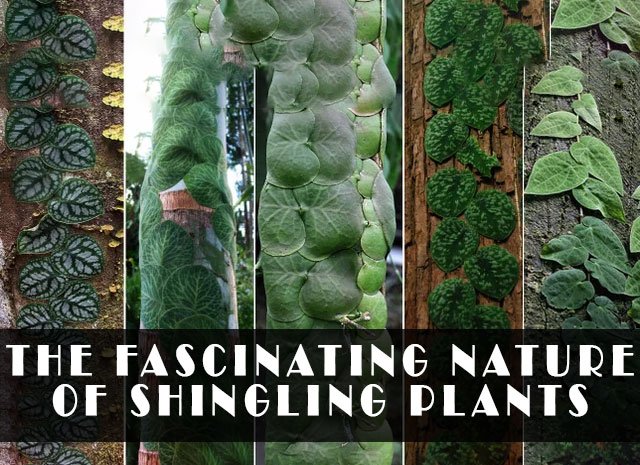

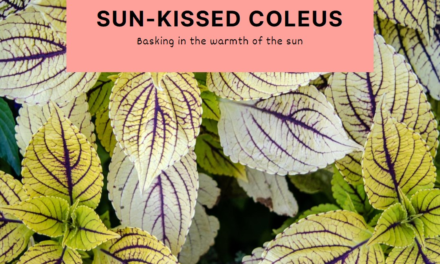
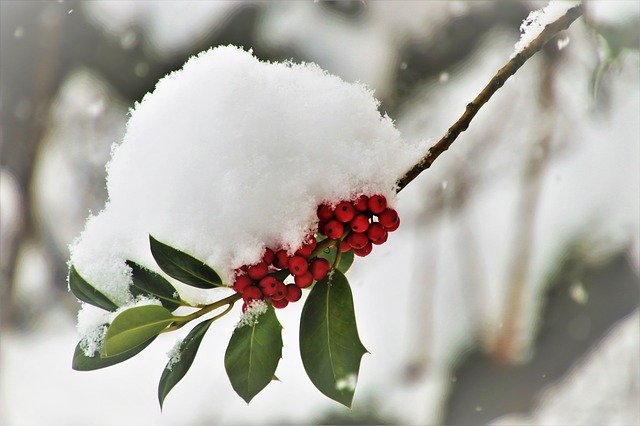

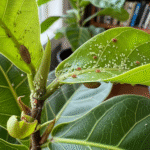
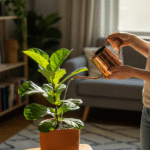
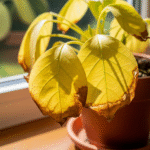
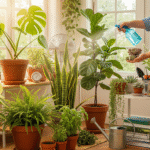
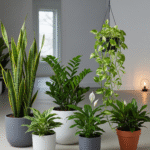
Thank you for writing this article. I appreciate the subject too.